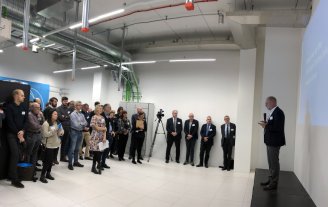Copyright 2012 neutronsources.org | All rights reserved. | Powered by FRM II | Imprint / Privacy Policy
Ready to turn data into discoveries
Date: 29 October 2019
Source: ESS

ESS has officially inaugurated the data centre infrastructure that will play a vital role in processing the enormous amounts of research data from experiments being conducted here.
The new data centre is a core component of the ESS Data Management & Software Centre (DMSC) which opened in 2016 in the Copenhagen Bio-Science park in Denmark. DMSC will provide the analysis and modelling software that enables researchers to transform experimental data produced at ESS into scientific results and innovative breakthroughs in materials science.
Denmark and Sweden are joint host countries for ESS. “As host country, Denmark plays an essential role for ESS and, on behalf of all the 13 member countries, I congratulate on this important milestone for ESS as a whole,“ said Vice Chair of the ESS Council, Kurt Nørgaard Clausen, who has been involved in the ESS project for a number of years. He added that, “on a personal note, as a former head of neutron scattering at the now closed research facility DR3 at Risø, it’s a great pleasure to see an important part of ESS on Danish soil”.
According to Director General of the Danish Agency for Science and Higher Education, Hans Müller Pedersen, the Data Management and Software Center in Copenhagen will provide high-performance computing for the scientific community. “Collaboration and synergies between ESS and the Danish research community will facilitate the integration of the DMSC into our research and innovation ecosystem,” said Pedersen.
When ESS is in full operation, the DMSC will handle and store large amounts of experimental scientific data, some 7-11 petabytes (PB) per year. The now-operational data centre is designed to scale up and increase to up to 30 server racks, ensuring sufficient capacity. “The DMSC design focuses on reliability, scalability and efficiency,” said Jonathan Taylor, Head of the DMSC. “We provide a resilient data centre infrastructure, which is crucial to ensure that the researchers using the instrument stations at ESS can carry out their experiments without interruption in their pursuit of scientific breakthroughs.”
The large amounts of experimental data generated at ESS in Lund will be transferred to Copenhagen through a >100 Gb/s fibre connection, provided by the Danish DeIC, Swedish SUNET and Nordic NORDUNET research networks. The data centre also makes use of the indirect free cooling of the Scandinavian climate through an active rear-door heat exchanger technology, the data centre will only need active energy-intensive cooling when the outside temperature is above 17°C.
Currently the DMSC staff consists of 32 employees, developing software and hardware for the control, analysis, and visualisation of the experiments at ESS, in collaboration with partners at universities and research laboratories all over Europe.
When the experimental research program at ESS is fully running, the DMSC is expected to have 60-70 employees and will provide more than 3,000 annual researchers at ESS access to analyse and interact with data generated by their experiments.
In line with the FAIR data principles (Findable, Accessible, Interoperable and Reusable), ESS will make the experimental scientific data openly available, for the benefit of the whole scientific community.